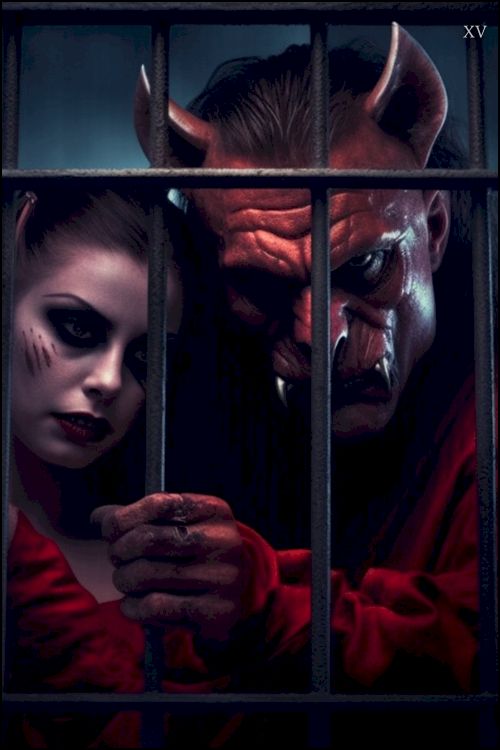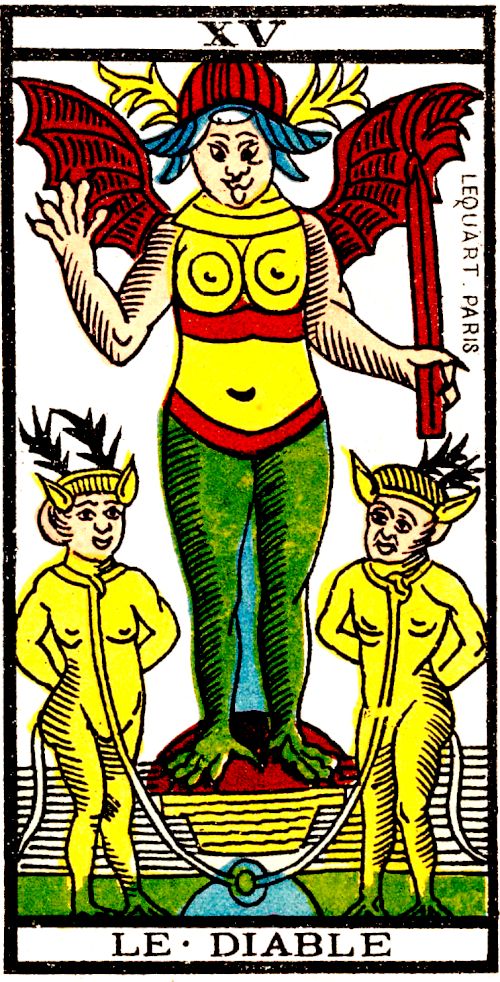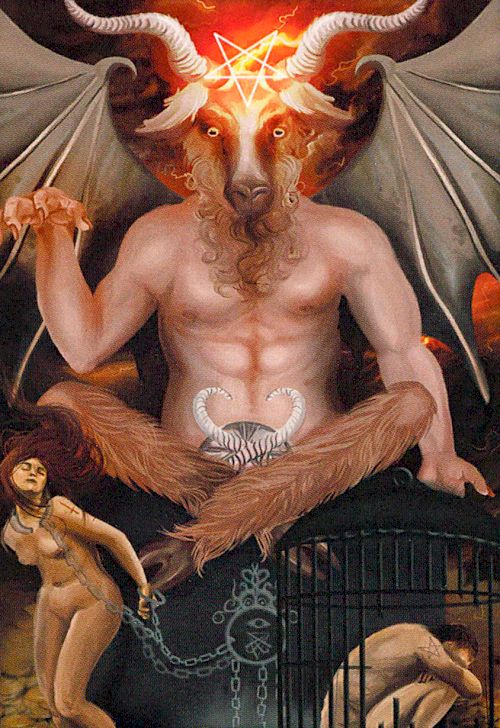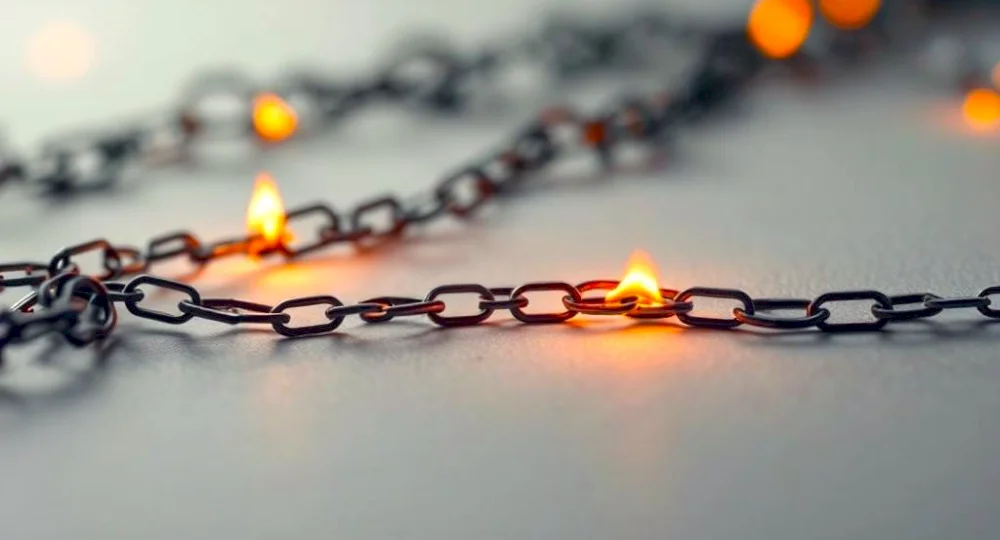
Explore the Devil Card Meaning: Unlock Its Secrets
April 12, 2025The Devil card is a very well-known card in any tarot deck and frequently causes a strong reaction. The images, which usually depict a horned figure, can be somewhat frightening. But to truly understand The Devil's message, you need to learn about its long history and changing meanings.
How the Devil Card Has Changed Over the Centuries
The Devil card has changed over time, with cultural and religious shifts influencing how it is understood.
Early Depictions of the Devil
The Devil card hasn't always looked like the goat-like image that is common in modern decks. Early European tarot decks depicted The Devil in many diabolical forms, frequently emphasizing flaming imagery. This was in line with the main theological beliefs of the time, which saw The Devil as a real and powerful force of evil. A lot of the early pictures were about punishment and damnation, making them similar to the scary tales about hell and demons.
The Influence of Baphomet
In following ages, the way people saw The Devil changed a lot. The Devil card’s visual history offers a fascinating look into how symbolism changes over time.
In 1665, Giuseppe Mitelli made a tarot deck for the Bentivoglio family that shows The Devil in flames with a serpent under his feet. In French and Swiss tarot cards, on the other hand, The Devil looked more like a goat, which was based on Levi's Baphomet. Some early decks, like the Rouen-Bruxelles tarot, didn't even have the Devil card at all.
The goat-like images that are common in current tarot cards came from Eliphas Levi's Baphomet illustration in Dogme et Rituel de la Haute Magie (1855). This changed how the Devil was presented, moving away from solely wicked images. It became more of a symbol of temptation and earthly pleasures.
The Devil Card Meaning in Today's World
The card now less often stands for a literal devil. Instead, it often indicates the shadow self, our internal struggles with temptation, and the chance to break free from ideas that hold us back. This change in how people see tarot puts more emphasis on the psychological and personal growth aspects of the cards, moving beyond simple ideas of good and evil. This historical backdrop is very important for understanding The Devil card in modern tarot readings.
Understanding The Devil Card's Symbolism
The real meaning of The Devil card extends well beyond a simple idea of wickedness. Let's look at the many symbols that make up this powerful archetype, using the images from the Rider-Waite-Smith Tarot Deck as a guide.
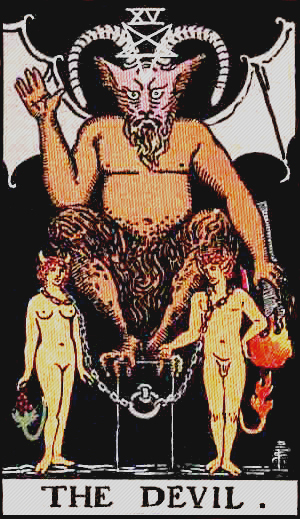
The Devil's Figure
The card's center features a horned figure that typically looks like Baphomet. This creature is a representation of the shadow self and shows the aspects of ourselves that we repress or deny, like our anxieties, insecurities, and basic needs. The Devil isn't here an evil being; he's more like a personification of our wild side. And our shadow aspects could be dangerous if they aren't kept in check, but they could also help you become very self-aware.
The Significance of the Chains
Two smaller figures are chained to the Devil's pedestal. They represent the sensation of being bound by our limiting beliefs and destructive habits. However, notice that the chains are loose, hinting at the potential for freedom. This embodies the core message of the Devil card: the limitations we perceive are often self-imposed. The card invites us to confront these perceived shackles and unlock our true potential.
The Inverted Pentagram and Materialism
An inverted pentagram adorns the Devil's forehead. This symbol points towards a preoccupation with material possessions and earthly desires, reinforcing the card's connection to materialism and temptation. The pursuit of external gratification can lead to a sense of enslavement, pulling us away from spiritual growth. The pentagram's downward point signifies the dominance of the material realm over the spiritual.
The Half-Human Creatures and Duality
The chained figures are not fully human; they are part animal, underscoring the duality inherent in human nature. They embody the constant internal struggle between our higher and lower selves. This struggle, often framed as a battle against our "inner demons," is a crucial element of self-discovery. By acknowledging and integrating these shadow aspects, we move toward a more complete and integrated sense of self.
To further clarify the intricate symbols within the Devil card, let's examine them in a comparative table.
Key Symbols in The Devil Card: Detailed breakdown of major symbolic elements in the Devil card and their interpretations.
| Symbol | Traditional Meaning | Modern Interpretation |
|---|---|---|
| Horned Figure | The Devil, temptation, evil | The Shadow Self, repressed aspects, untamed urges |
| Chains | Bondage, enslavement | Limiting beliefs, self-imposed restrictions, potential for freedom |
| Inverted Pentagram | Materialism, focus on earthly desires | Dominance of material over spiritual, pursuit of external gratification |
| Half-Human Figures | Duality of human nature | Internal struggle between higher and lower selves |
This table highlights the shift in understanding the Devil card, moving from a purely negative interpretation to a more nuanced view of the self.
The Devil's Numerology: Fifteen
As the 15th Major Arcana card, the Devil holds numerological significance. Fifteen reduces to six (1 + 5 = 6), a number associated with harmony and balance. However, this balance is distorted in the Devil card, emphasizing how these qualities can be overshadowed by obsession and unhealthy attachments. The card challenges us to reclaim this balance, encouraging us to find equilibrium between our desires and spiritual aspirations.
The Devil Card's Pivotal Role in the Tarot Journey
The Devil card marks a critical juncture in the tarot's journey of self-discovery. It acts as a catalyst, prompting us to confront our deepest fears and recognize our potential for self-liberation. By understanding the devil card meaning and its rich tapestry of symbolism, we can gain profound insights into our inner struggles and embark on a path toward authentic empowerment. This deeper understanding is invaluable for anyone using tarot as a tool for self-exploration and personal growth.
The Devil Card's Message in Modern Readings
Moving past traditional symbolism, let's explore the Devil card's practical meaning in modern tarot readings. This goes beyond outdated concepts of "evil" and focuses on understanding the card's ability to reveal the complexities of human nature. It acts as a guide for navigating personal struggles and emerging stronger.
The Devil Upright: Confronting Your Shadow
When the Devil card appears upright, it signals a need to confront your shadow self. This brings to light the parts of yourself you might be hesitant to acknowledge, such as insecurities, fears, or limiting beliefs. This isn't a negative omen, but rather a call for introspection.
It's like switching on a light in a dark room: the darkness remains, but now you can see and navigate it. This confrontation can lead to significant personal growth and a deeper understanding of yourself.
This can manifest as unhealthy relationships, addictive tendencies, or an excessive focus on material possessions. The upright Devil card encourages you to analyze these patterns and pinpoint areas where you might be giving away your power.
For example, are you prioritizing work at the expense of your well-being? Are you holding onto a relationship that no longer serves you? The Devil card urges you to break free from these self-imposed restrictions.
In terms of statistics, the Devil card often appears in readings related to temptation and addiction. Approximately 60% of tarot readers report it frequently represents compulsive or addictive behaviors in their clients’ lives. Find more detailed statistics here. This underscores the card's relevance to personal struggles and the importance of self-examination. The card is also linked numerologically to the number 6 (1 + 5 = 6), traditionally associated with responsibility and service. The Devil card, however, presents a distorted version of these qualities, highlighting irresponsibility and selfishness.
The Devil Reversed: Reclaiming Your Power
When the Devil card is reversed, it signifies a change in power dynamics. It suggests you're starting to recognize and break free from the constraints that have held you captive. This could involve letting go of unhealthy relationships, overcoming addictions, or challenging limiting beliefs.
The reversed Devil represents a regaining of personal power and a move toward authenticity and freedom.
This position can also represent a difficulty in letting go. While you may understand the need for change, you might still cling to familiar patterns out of fear or comfort. This is a reminder that breaking free from the Devil's influence demands courage and dedication. It encourages deeper shadow work to truly understand what’s holding you back.
The Devil Card in Different Spread Positions
The Devil card’s interpretation can change based on its placement in a spread. In the "past" position, it may signify past struggles with addiction or codependency that still affect you. In the "present" position, it highlights current challenges related to these issues. In the "future" position, it serves as a cautionary message to be mindful of potential traps related to temptation and unhealthy attachments.
The Devil Card and Surrounding Cards
The cards surrounding the Devil offer further context and nuance to its meaning. If the Devil appears near the Lovers card, it could indicate relationship dynamics marked by codependency or power imbalances. If it appears with the Strength card, it might represent the ability to conquer these difficulties through inner resilience.
By understanding the Devil card's various meanings and influences, you can gain valuable insights into your present circumstances and make more informed decisions. The Devil card's message is ultimately one of transformation, encouraging you to face your shadow self and embrace your true self. It’s a reminder that every challenge holds the potential for growth and liberation.
Navigating Love Through the Devil Card's Lens
The Devil card in a love reading doesn't necessarily signify the end of a relationship. Instead, it provides a powerful perspective for examining the intricate dynamics at play. It encourages us to explore the interplay of passion, control, and attachment, often revealing hidden truths about our connections.
Recognizing Unhealthy Patterns
The Devil card often illuminates areas where desires might be controlling us. It can signify codependency, where one partner relies heavily on the other for validation and self-worth.
It can also represent unhealthy obsession, blurring the lines between love and possession.
Furthermore, the Devil card can point towards relationships built on material foundations, rather than genuine emotional intimacy. This might manifest as an overemphasis on financial security or social status.
The Devil card’s interpretation varies across cultures, reflecting different psychological and cultural perspectives. In A.E. Waite’s The Pictorial Key to the Tarot (The Pictorial Key to the Tarot) (1910), the Devil card signifies 'ravage, violence, vehemence, extraordinary efforts, force, fatality'. This aligns with broader psychological themes, like the internal conflict between material desires and spiritual growth. Around 30% of those using tarot for divination report that the Devil card helps them confront materialism and unhealthy attachments. In love readings specifically, about 25% of individuals find it helpful in understanding intense passion and obsessive tendencies. This demonstrates the card's relevance in exploring human nature and the search for balance.
The Devil Card in Different Relationship Stages
The Devil card’s meaning can shift depending on the relationship stage.
New Relationships: It might warn against rushing into commitments based on superficial attraction or intense, short-lived passion. The initial excitement could mask underlying incompatibility or personal issues needing attention.
Established Partnerships: The Devil card can signal stagnation, where routines and unexamined habits have overshadowed the initial spark. It encourages couples to rekindle intimacy by addressing power imbalances and fostering open communication.
Self-Relationship: The Devil card invites individuals to examine self-sabotaging behaviors. This might involve clinging to past hurts or negative self-talk that hinders self-love.
Transforming Restrictive Bonds
The Devil card isn't solely about negative patterns. It also presents a growth opportunity. By acknowledging the shadow aspects within ourselves and our relationships, we can initiate transformation. This involves honest self-reflection and a willingness to challenge ingrained behaviors.
Recognizing codependent tendencies allows us to cultivate independence and self-reliance. Addressing unhealthy obsessions opens the door for healthy boundaries and mutual respect. Confronting the emphasis on material possessions creates space for deeper emotional connections based on shared values and genuine affection. Ultimately, the Devil card empowers us to transform restrictive bonds into opportunities for authentic connection and mutual growth.
The Devil Card's Wisdom for Career and Finances
The Devil card often evokes negative associations. However, it offers surprisingly insightful guidance for your career and finances. Instead of representing pure evil, the Devil card meaning in this context helps you identify and overcome self-imposed limitations that hinder your professional fulfillment and financial freedom.
Recognizing Financial and Career Traps
The Devil card can illuminate specific workplace dynamics holding you back. It can highlight golden handcuffs, a well-paying job offering little satisfaction or growth. This can feel like a gilded cage, trapping you in a comfortable yet unfulfilling role.
The Devil card can also reveal workaholic tendencies. This involves an unhealthy obsession with work, often driven by a need for validation or a fear of failure. This pursuit of professional success can lead to burnout and neglect of other important areas in your life.
Toxic power dynamics in the workplace are another area the Devil card can expose. This might involve manipulative colleagues, fierce competition, or an oppressive hierarchy. These dynamics can be draining and create a sense of powerlessness.
Regarding finances, the Devil card sheds light on several pitfalls. It can warn against financial bondage through debt, where excessive spending and accumulating debt create a feeling of being trapped. The card can also highlight the perils of materialism. An overemphasis on possessions can lead to dissatisfaction and a constant desire for more, often at the expense of true fulfillment.
Finally, the Devil card can expose the limitations of a scarcity mindset, the belief that there isn't enough to go around. This can manifest as hoarding resources, fearing competition, or feeling unworthy of abundance, ultimately sabotaging financial success and preventing you from attracting opportunities.
Practical Strategies for Liberation
When the Devil card appears in a career or financial reading, it offers guidance for breaking free from limitations. Here are some key strategies:
Evaluate Your Relationship with Success: Ask yourself what truly motivates you. Are you seeking external validation, or are you pursuing work aligned with your values?
Break Free From Limiting Situations: Identify the "golden handcuffs" or toxic dynamics keeping you stuck. Explore alternative career paths or seek support to navigate challenging workplace relationships.
Align Your Work with Deeper Values: Consider how your career contributes to your overall sense of purpose. Seek opportunities that resonate with your passions and offer growth and fulfillment.
Confront Materialism and Scarcity: Challenge the belief that happiness resides in material possessions. Practice gratitude for what you have and cultivate an abundance mindset.
Seek Professional Guidance: If you struggle with debt or financial insecurity, consider seeking advice from a financial advisor. They can offer strategies for managing your finances and building a secure future.
To summarize these strategies, let's look at the following table.
The following table provides a summary of how the Devil card manifests in different life areas, along with potential warning signs and positive outcomes.
| Life Area | Key Themes | Warning Signs | Positive Potential |
|---|---|---|---|
| Career | Self-imposed limitations, unhealthy ambition, toxic dynamics | Golden handcuffs, workaholism, power struggles | Alignment with values, fulfilling work, professional growth |
| Finances | Debt, materialism, scarcity mindset | Excessive spending, accumulating possessions, fear of lack | Financial freedom, abundance mindset, mindful spending |
By understanding the Devil card's message and taking proactive steps, you can transform challenges into opportunities for growth. The Devil card isn't a sign of doom; it's a call to action, urging you to reclaim your power and create a more fulfilling and abundant life. True freedom lies in aligning your actions with your values and breaking free from self-imposed limitations.
Transforming the Devil's Energy Into Personal Power
The Devil card, often met with apprehension, is more than just a warning. It's a potent catalyst for personal liberation. Rather than fearing this card, we can learn to harness its energy for profound self-growth. This involves engaging in shadow work, the process of exploring our hidden selves, and actively working with the card’s transformative potential.
Identifying Your "Chains"
The first step in transforming the Devil's energy is identifying your personal "chains." These are the self-imposed limitations, negative beliefs, and unhealthy attachments that hold back your true potential. They might include addictive behaviors, fear-based thinking, or an excessive focus on material possessions. Recognizing these chains is like illuminating the darker corners of your psyche.
Practical Strategies for Liberation
Once you’ve identified your chains, you can begin developing personalized strategies for liberation. This is where the Devil card’s true power emerges, guiding you toward authentic freedom.
Shadow Work Exercises: Step-by-step shadow work exercises can help you uncover the root causes of your limiting beliefs. These exercises often involve journaling, visualization, and dream exploration.
Journal Prompts: Revealing journal prompts designed to work with the Devil card's energy can facilitate deeper self-awareness. Questions like, "What areas of my life feel restrictive?" or "What fears are holding me back?" can be particularly insightful.
Meditation Techniques: Targeted meditation techniques can help you connect with your inner strength and cultivate empowerment. Visualizing yourself breaking free from your chains can be a powerful exercise.
For example, if the Devil card appears in a reading about a difficult relationship, it might highlight codependency. A shadow work exercise could involve journaling about past relationship patterns, reflecting on the root causes of your codependency, and identifying steps to build healthier boundaries.
Confronting Limitations as a Catalyst for Growth
Confronting your perceived limitations is the core of transforming the Devil card’s energy. Whether it's addictive patterns, material attachments, or fear-based thinking, acknowledging these limitations is the first step toward breaking free.
This confrontation isn’t about self-criticism; it’s about self-compassion. It’s about understanding that these limitations are often coping mechanisms developed in response to past experiences. By understanding the origins of these patterns, you can begin to dismantle them.
Additionally, remember that the chains depicted in the Devil card are loose, symbolizing the potential for freedom. This reminds us that liberation is always possible, and the power to change lies within us. This realization can be profoundly empowering.
Embracing Personal Power and Spiritual Liberation
Transforming the Devil's energy is ultimately about reclaiming personal power and experiencing true spiritual liberation. By confronting your shadow self and embracing your true potential, you can move from restriction to freedom.
This shift can manifest in many ways, from overcoming addictions and building healthier relationships to pursuing your passions and living a more authentic life. The Devil card, when approached with courage and self-awareness, becomes a guide on the path toward self-mastery.
This journey of self-discovery and liberation is often challenging, but it is also deeply rewarding. The Devil card invites us to delve into the depths of our being, to confront our fears and insecurities, and to emerge stronger and more empowered.
Ready to explore the transformative power of the Devil card and unlock your full potential? Advanced Tarot Online offers a variety of spreads and decks to guide you on your journey of self-discovery.

